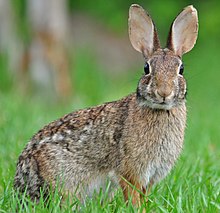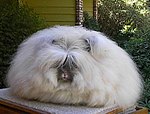The Lagomorpha portalThe lagomorphs (/ˈlæɡəmɔːrf/) are the members of the taxonomic order Lagomorpha, of which there are two living families: the Leporidae (rabbits and hares) and the Ochotonidae (pikas). There are 110 recent species of lagomorph of which 109 are extant, including 10 genera of rabbits (42 species), 1 genus of hare (33 species) and 1 genus of pika (34 species). The name of the order is derived from the Ancient Greek lagos (λαγώς, "hare") + morphē (μορφή, "form"). (Full article...) Selected article Br'er Rabbit ("Brother Rabbit") is a central figure in the Uncle Remus stories of the Southern United States written down by Joel Chandler Harris. Br'er Rabbit is a trickster who succeeds by his wits rather than by brawn. The Br'er Rabbit stories can be traced back to trickster figures in Africa, particularly the hare that figures prominently in the storytelling traditions in West, Central, and Southern Africa. The 1946 Disney film Song of the South is a frame story based on two Br'er Rabbit stories, "The Laughing Place" and "The Tar Baby". He also has a cameo appearance in Who Framed Roger Rabbit (1988). Selected breed
The Angora rabbit (Turkish: Ankara tavşanı) is a variety of domestic rabbit bred for its long, soft wool. The Angora is one of the oldest types of domestic rabbit, originating in Ankara, Turkey, along with the Angora cat and Angora goat. The rabbits were popular pets with French royalty in the mid 18th century, and spread to other parts of Europe by the end of the century. They first appeared in the United States in the early 20th century. They are bred largely for their long Angora wool, which may be removed by shearing, combing, or plucking. There are many individual breeds of Angora rabbits, four of which are ARBA-recognized.
Selected quote
SubcategoriesRelated portalsSelected image Fleuron from the book "The principles of drawing" (1752) Fleuron from the book The principles of drawing (1752). Fleurons are typographic ornaments that were frequently used in 18th- and 19th-century books.
Selected video
Did you know"Rabbit" in…Get involvedFor editor resources and to collaborate with other editors on improving Wikipedia's Lagomorpha-related articles, see WikiProject Mammals. Things you can do
TopicsAssociated WikimediaThe following Wikimedia Foundation sister projects provide more on this subject:
Purge server cache |












